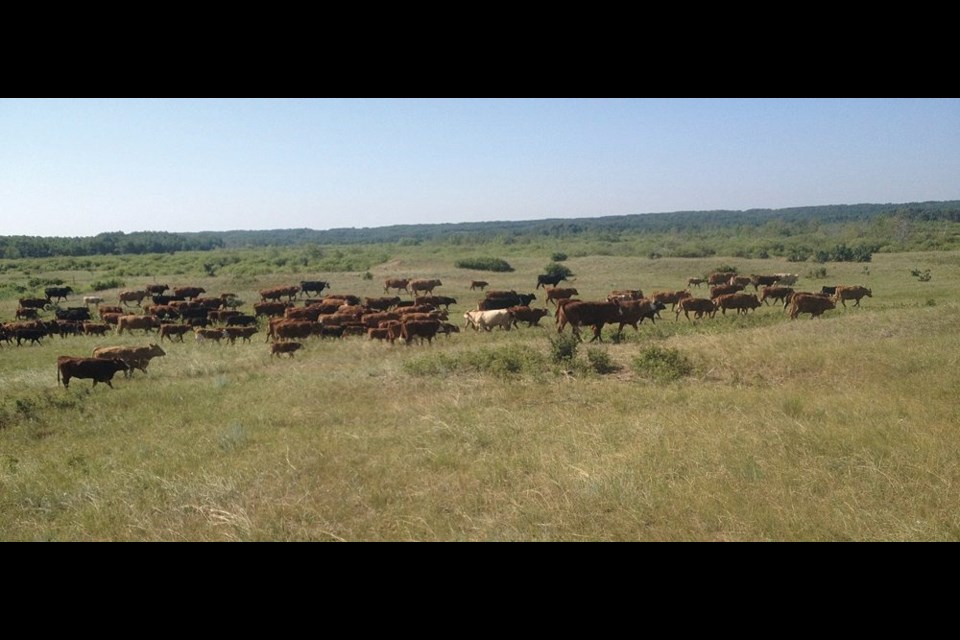All Manitobans gain from this province’s community pastures, according to a new study that details the broad range of social and environmental benefits derived from them, and assigns a dollar value to them too.
Released last week by the Association of Manitoba Community Pastures (AMCP) the study pegs the value of ecosystem services derived from this province’s 20 community pastures at $13.35 million annually.
These 350,000 acres are comprised mostly of provincial Crown land and are among the largest and last remaining contiguous blocks of prairie grassland.
The report titled The Social and Environmental Benefits of AMCP Community Pastures and led by the International Institute for Sustainable Development (IISD) has quantified the direct monetary and non-monetary values of these landscapes, including their role in carbon sequestration, soil conservation and support for biodiversity.
It also points out the key role the AMCP plays to enhance these services through management practices such as prescribed burns and rotational grazing.
“Sustainable grazing methods championed by AMCP provide benefits to livestock producers and society at large,” said Geoff Gunn, a geographer at the IISD and the report’s author.
“Our study shows that these lands store more carbon in the soil, provide better habitat for prairie species, and clean our water all while providing grazing for livestock.”
Topping the lists of benefits coming off these pastures include the value of their forage supply to the livestock sector and carbon sequestration.
The forage supply alone from these sites is worth $5.67 million. Over 350 patrons graze a total of 40,000 head on these sites annually.
The study also shows AMCP pastures are worth $4.7 million a year for their role, as large undisturbed tracts of land, in carbon sequestration.
Another $825,000 in ecological services is derived from community pastures support for healthy soils, as well as diverse plant and animal habitats, including habitat for numerous species at risk such as threatened birds and flora such as the small white lady’s slipper, and western silvery aster.
Additionally, they are worth another $1.2 million to all Manitobans for the recreation, heritage and research services they provide. Activities such as scientific studies, wildlife viewing and hunting were factored into that valuation. The cultural value of these tracts of land as sacred sites, and places for traditional food harvesting through hunting, trapping, and fishing was also accounted for.
Community pastures also provide an additional $860,000 yearly to rural economic development through job creation and local purchasing. Even limited activities such as gravel extraction and timber harvesting is conservatively estimated at over $90,000 annually, the study said.
The total value of ecological goods and services derived from retaining community pastures can actually range from anywhere from $10.57 million and $18.88 million yearly, the report noted.
“This report is the first to look specifically at AMCP community pastures, and the benefits they bring to society at large,” said Barry Ross, general manager of the AMCP.
Barry Lowes, chair of the Association of Manitoba Community Pastures said it confirms what he’s always known as a livestock producer — that the community pastures are a valuable program integral to rural communities and they improve the environment through managed livestock grazing.
“AMCP community pastures support the livestock industry and rural economies, and are well used by the public – the benefits of this program for Manitoba are numerous,” he said.
The study will be an important reference document as the province moves forward to achieve new conservation and climate change mitigation goals.
The Manitoba government recognizes these values and has supported the AMCP to keep these pastures operating sustainably, said Ross.
“Now that dollar values are associated with the community pasture program, this report will serve as a tool to help attract new funding sources and develop new projects, such as carbon storage on grasslands, that support provincial climate change objectives.”
AMCP range technician Rachel Whidden said the study’s findings importantly will help to communicate to the broader public how important these landcapes are. The report itself noted there isn’t an understanding within the public of the role or benefits of the community pasture program.
“The publication of this report is our first step towards increasing awareness among Manitobans,” said Whidden.
“It’s a clear demonstration of the importance of some of the largest intact blocs of native prairie remaining in Manitoba. These have become very rare and we’d like to highlight the larger benefits that they serve in Manitoba.”
There are relatively few large remaining tracts of prairie grassland found anywhere in the country, with conservation groups estimating more than 70 per cent of all prairie grasslands in Canada have been converted to other uses and what’s left now vulnerable to further encroachment and human impact.
Funding for this study was provided by the federal and provincial governments through Growing Forward 2. It was developed in conjunction with an expert steering committee comprised of Manitoba Agriculture representation and an independent forage expert.
The IISD and researchers with the University of Saskatchewan employed a process called total economic valuation (TEV) which includes both direct monetary and non-monetary values to derive its numbers.
The AMCP was incorporated in 2014 and initially organized by concerned pasture patrons in the province after the federal government announced it would discontinue operating community pastures (formerly through the Prairie Farm Rehabilitation Administration).
The AMCP is now operating 20 community pastures in Manitoba and along the Saskatchewan border including at Alonsa, Bield, Birch River, Cote-San Clara, Ellice-Archie, Ethelbert (Dauphin and Duck Mountain), Gardenton, Pansy, Langford, Lenswood, Libau, McCreary, Mulvihill, Narcisse, Pasquia, Spy Hill-Ellice, Sylvan-Dale, Turtle Mountain, and Wallace.




